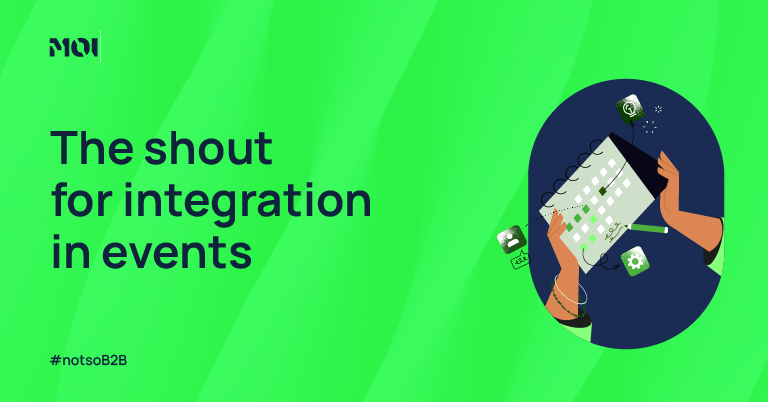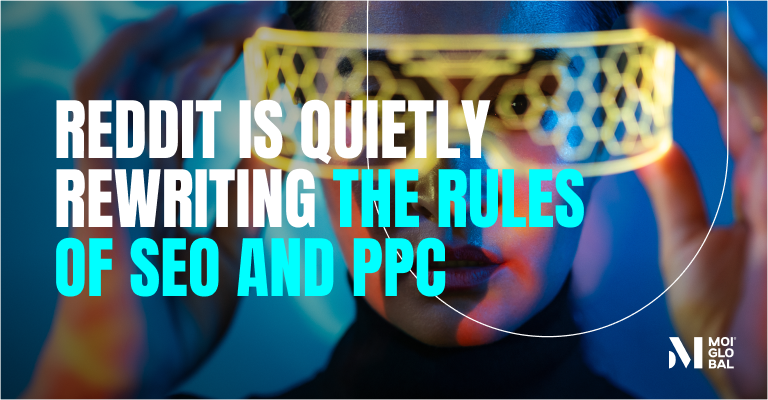
More noise doesn’t equal more impact. Now read that again – slowly.
We get it. Markets are becoming more and more saturated, attention spans are hitting all-time lows and the temptation to scream louder than ever in order to be heard is hard to resist. But when it comes to B2B events, louder isn’t always better. It’s time to let your events speak for themselves.
Nowadays, there’s a glaring gap in how we approach creativity in events. And it all comes down to one simple – often missing – ingredient: integration.
With an integrated event strategy, you don’t need to shout over other brands to be heard. Your events and the lasting impression they make do all the talking for you.
Allow us to break it down…
Creativity needs integration
At MOI, we’ve long believed in the power of bold, head-turning ideas to fuel engagement. But what good is it if those ideas only live on stage for 30 minutes, in a booth corner, or on a microsite buried three clicks deep?
Too many creative sparks are treated like fireworks. Brief. Impressive, even. But fleeting. What’s missing is the connective tissue: a throughline that stitches these moments into a larger, strategic narrative. And that’s where integration steps in.
It’s the gas that feeds the creative spark, taking it from an ember into a roaring fire that engulfs your entire event strategy.
(Ok – we’ll stop with the cheesy metaphors. But you get the gist.)
So, what does integration in events actually mean?
Let’s define it clearly. Integration in events isn’t just syncing calendars and channels. It’s about orchestrating the attendee journey – before, during, and after the event.
It’s where brand, sales, marketing, and digital collide to create a seamless, unforgettable experience for your customers. So that, when the doors of the venue close and the last few attendees file out, the brand experience doesn’t end there. It follows them, leaving a lasting impression that will fuel long-term loyalty.
That integration starts at the very beginning, when brainstorming ideas for your event. It’s not just about coming up with something ‘different.’ It’s about making that difference resonate and connect across every touchpoint, driven by:
- Insight – Understand your audience beyond personas. Understand them as people. What keeps them up at night? What do they look for in experiences? Use this insight to architect the event.
- Disruption – Do something unexpected: a different format, a provocative topic, a radical location. But make it purposeful.
- Immersion – Use physical and digital tools in tandem. Think interactive installations, real-time content, or collaborative experiences. Technology is your friend – leverage it.
- Action – Not just QR scans, but intent-led conversations and meaningful interactions with your audiences. Face-to-face interactions are powerful. Don’t underestimate them.
- Nurture – Don’t let the conversation end with the event. Repurpose content. Check in with leads. Keep the story going beyond the curtain call. You need to maximize your event’s value beyond the event itself.
Provocation is no longer optional – it’s strategic
We don’t deal in safe ideas, and events are no exception.
A truly creative, memorable event strategy must be provocative – but provocative with purpose. It should challenge, surprise, and provoke thought.
But provocation without integration becomes gimmicky. Sure, you might get the clicks and claps, but not the conversations.
By aligning creative disruption with integrated planning, you don’t just surprise people. You move them. And isn’t that the goal of any B2B experience?
Integration IS the creative differentiator
When every element of your B2B event strategy is aligned and connected, bold ideas are given the space to truly shine. They’re not just a spur-of-the-moment spark of creativity that inevitably dwindles, but genuine examples of data-driven, strategic, executable ideas that turn heads, win hearts, and drive long-term loyalty.
At its core, integration in events helps businesses unlock:
- Stronger storytelling: A consistent narrative across sessions, formats, and follow-ups.
- Better alignment: When sales, marketing, and brand work as one, the attendee experience feels effortless.
- Measurable impact: Integrated strategies mean integrated data – helping you see, track and prove ROI across your events strategy.
The shout for integration can no longer be ignored
For too long, B2B events have been treated as independent entities, disconnected from broader B2B strategies and goals. They’re seen as a standalone, one-and-done project. But just like any marketing strategy, events cannot thrive in silo.
It’s time we stopped treating events as their own island. When integrated into a wider B2B strategy, they have the power to not only demand attention, but stick with your audiences. And that’s precisely what B2B events should be about. Not just a quick-win lead-gen tactic, but a strategic tool to amplify awareness, drive loyalty, and meet your customers where they are.
Ready to see what’s possible with an integrated approach to B2B events? Get in touch with our team to learn more.


